It’s beginning to look like the meek may not inherit the earth after all, brethren, but if they’re as meek as these five bikes were ten years ago, that’s a good thing. Truly, a couple of these are still around – one has grown into a real motorcycle for not much more money than ten years ago, and one remains as it was then, but for quite a bit more coin. The others seem to have disappeared into the mists of time. Sad. OK, not really.
2009 250cc Streetbike Shootout
CFMoto V3 Sport vs. Hyosung GT250R vs. Johnny Pag FX/3 vs. Kawasaki Ninja 250R vs. Suzuki TU250X
Performance-driven sportbikes, cruisers of various displacements and their flashy custom cruiser brethren dominate the current American street motorcycle culture.Standard-style, sport-tourers, full-on touring sleds and a sprinkling of vintage machines round out the rest of what most of us ride. Lost in the shuffle of 160-hp near race-spec rockets and $40K ego boosters are the little ‘uns.
Walk into any large, multi-line dealership and see how many mighty-mites you can find. Ask the sales team if they have a few 250s to look at, and they’ll likely show you two, 50cc mini-motos or maybe a pastel-colored scooter.
But if you’re an urban dweller with little need to travel the Super Slab, or play Ricky Racer on the weekend, and have an eye toward fuel economy and low MSRPs, then, like us, you’ll agree the little bikes deserve more time in the limelight.
|
|
We wanted to take a closer look at this market segment that’s often forgotten, so we collected five machines with various engine configurations all in the 250cc range, and created a 250cc Streetbike Shootout!
One is a 250 icon; one blends perfectly classic UJM looks with modern tech, and another wraps its quarter-liter heart in bigger bike looks. A fourth bike is a testament to pursuing the American entrepreneurial dream. And the fifth contestant is, well, let’s just say it’s a little hard to define.
|
|
Johnny Pag FX/3 $3,399
31.1-inch seat height, claimed dry weight 350 lbs, 12 months warranty
The FX/3 graced the electronic pages of Motorcycle.com not long ago when we spent the day with Johnny “Pag” Pagnini, CEO and founder of Johnny Pag Motorcycles.
As we learned in the JPM Review each motorcycle is designed entirely in-house at Pag’s Orange County, CA, headquarters, but a Shanghai-based company manufactures the motorcycles.
The FX/3 is one of six bikes in the current Pag line, all of which are powered by a 270cc, carbureted (dual 26mm Keihin), liquid-cooled, DOHC, 5-speed, Parallel Twin. The FX is the only non-cruiser-ish unit in the Pag line-up. It’s a standard-style bike, with an open, mostly upright riding position.
It looks like the urban brawler of the bunch, with its all-black color scheme, dual underseat exhaust and fairing-less, bare-bones style. A pair of coil-over shocks draw attention to the airy section around the 15-inch rear wheel, while a small luggage rack as standard is an unexpected add-on. A dual-piston sliding-pin caliper pinches a single rotor up front, while virtually the same set-up out operates out back.
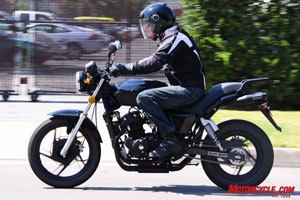 We liked the ergonomics and styling of the Johnny Pag FX/3, but a mechanical issue during our group ride kept us from fully learning how it compares with the others.
We liked the ergonomics and styling of the Johnny Pag FX/3, but a mechanical issue during our group ride kept us from fully learning how it compares with the others.
Unfortunately for the FX/3 a minor mechanical issue led to a major electrical short that caused routine blowouts of the main fuse. Therefore the Pag didn’t make it past the first third of our group ride.
The electrical problem stemmed from cooling fan bolts that had backed out due to prominent vibration from the Parallel Twin. As the radiator fan worked itself loose, its electrical connectors were making contact with metal somewhere, causing a short. JPM recognizes this issue; so Locktite-ing the bolts are now part of its PDI servicing. For whatever reason, the bolts on our test bike didn’t receive this treatment.
On a previous day, a two-up ride over the span of six freeway miles was a little more than the FX could handle on a warm day. It overheated, coolant leaked, and a small amount of oil also seeped from somewhere. Also noteworthy was the observation by Gene Thomason of Gene’s Speed Shop (310-704-4544) in Torrance, CA – where all five bikes were put on a SuperFlow dynamometer – that the FX/3 didn’t appear to have a rev limiter.
|
|
JPM claims the FX produces (at the crankshaft) 23.8 hp and 18.5 ft-lbs at 6500. Dyno time revealed rear-wheel power peaks of 18.8 hp at 7,250 rpm, and 14.9 ft-lbs at 5,500 rpm. That’s good for third overall most power and torque in the group.
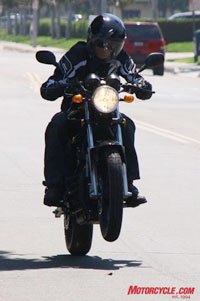 Conceptually, we all liked the Johnny Pag FX/3, but the poor execution of a few details soured our overall impression.
Conceptually, we all liked the Johnny Pag FX/3, but the poor execution of a few details soured our overall impression.
Regardless of the FX/3’s worst day ever, we did get in a few miles before it took itself out of the game.
Of the 18-inch front and 15-inch rear wheels, Editor Duke said they were “cheesy off-the-shelf” pieces, but he recognized they help keep costs down. Duke also wasn’t impressed with the rear suspension, saying it “damped as well as a bobblehead.”
Though the lil’ Twin managed respectful output, the vibration it produced was almost unbearable according to seasoned moto-journo and guest tester, Tom Roderick. “The bike vibrated like an industrial strength sewing machine cross stitching chainmail,” said T-Rod. And we judged power and feel from the modest single-disc front brake as weak.
“…it seems the best qualities of the Johnny Pag FX/3 are found in its appearance and ergos.”
Veteran rider and moto-industry lifer, Alice Sexton, represents our female and shorter inseam perspective. Of the overall rider environment, Alice remarked that the FX provided a “perfect seating position for around town … anyone could touch flat-footed.” She also said all the controls were “easy to use and in the right place.”
Alas, it seems the best qualities of the Johnny Pag FX/3 are found in its appearance and ergos. Looking like a tough lil’ feller will only get you so far, even in this budget-minded market segment.
 |
CFMoto V3 Sport $3,499
27.0-inch seat height, claimed dry weight 392 lbs, 2 yr warranty
What do you want to be when you grow up? A tough question for most of us, but if you could ask that question of the V3 Sport from Chinese motorcycle and scooter manufacturer, CFMoto, the oddly styled scootercycle would sound just like an enthusiastic child. “An astronaut! No, a doctor! A fireman … !”
The V3 is something of an anomaly in this group. The remaining four are all clearly motorcycles, but the V3 is in reality a scooter fully enclosed in bodywork.
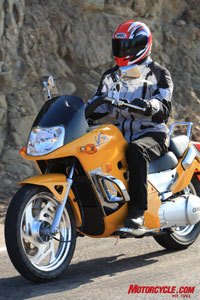 Hey, if this Chinese feller who rides pricey Italian motorcycles almost exclusively is willing to ride this Chinese machine, what’s your excuse?
Hey, if this Chinese feller who rides pricey Italian motorcycles almost exclusively is willing to ride this Chinese machine, what’s your excuse?
Though it looks as if a sizable Twin or something might reside midship, the fact is that the V3 is powered by scooter engine. A 244cc four-stroke, carbureted, liquid-cooled, SOHC, CVT Single propels the CFMoto with a modest 10.9 rwhp and 9.2 ft-lbs at 6,250 rpm. CFMoto claims the V3 mill makes about 18 crankshaft horsepower and 18 ft-lbs at 5,500 rpm.
Motorcycle-size wheels, 18-inch front, and 15-inch rear, help give the V3 a cruiser-ish stance, as does the relaxed riding position. Just like a scooter, both front and rear brakes are operated by hand levers, so be warned if you’re looking to stomp your right foot down on the brake pedal, ‘cause it ain’t there!
Speaking of the rear brake, it often suffered an incredible amount of fade after only a few miles at near full throttle, roughly 70-80 mph indicated. The rear brake lever (on the left bar) required two or three good pumps before fluid pressure returned, at which time the brake would function normally. For some reason around-town riding didn’t generate this effect.
Braking performance from the single front rotor/dual-piston sliding-pin combo was sufficient to eventually slow “the Dragon,” as it affectionately came to be known. However, as El Duke noted, with the V3’s heavy rearward weight bias, “application of the rear brake significantly aids deceleration.”
Power is about what you’d expect from, well, from a 250cc scooter. The V3 needs a few seconds to build a head of steam, but once under way there’s decent throttle response and generally the engine spools up in a linear manner. Just twist and go!
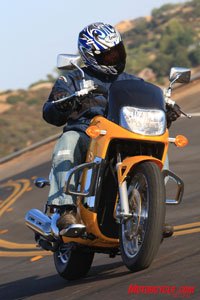 We wanted to hate it, but in the end we have a soft spot for the V3 Sport. Okay, mostly ‘cause it’s got a radio.
We wanted to hate it, but in the end we have a soft spot for the V3 Sport. Okay, mostly ‘cause it’s got a radio.
On the interstate, or just about anywhere the bumps and expansion cracks are sizable, the V3’s spindly suspension allows the front-end to “seek,” and the rear-end to compress rather harshly, and your spine along with it.
Limit riding to in-town, though, and the kicked-back seating position, comfortable saddle and idiot-proof auto trans can, at times, make riding the Dragon an entertaining, if not wholly enjoyable, experience.
Surprisingly, the V3 steers comparatively quickly considering its relaxed geometry.
We’ll let you decide the V3’s ultimate fate when it comes to styling, but know that plastic abounds, including various chrome-looking parts. The dash is rudimentary but useful; brake levers are adjustable, and best of all, there’s an AM-FM radio, with presets and an AUX port for your MP3 player!
Yes, the CFMoto pulls one out of the hat, and trumps all in the competition with a truly worthwhile feature for someone that might take the plunge and write a check for the V3.
There’s a centerstand, too. However, it’s quite possibly more difficult to operate than centerstands on bikes twice the weight, as the stand is simply too short to offer good leverage for lifting.
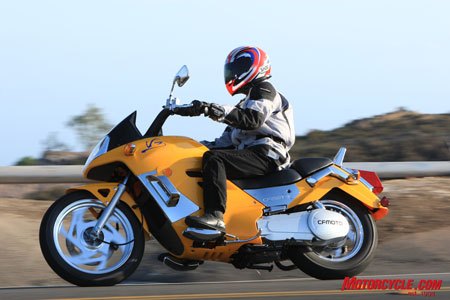 |
On the downside, overall build quality is borderline chintzy – though not any worse than the Pag – as evidenced by the poor-fitting fuel door that occasionally popped open. And, believe it or not, there wasn’t any storage, at least that we could find. Odd drawback for what is basically a scooter.
The bright yellow scheme wasn’t our cup of tea, but we think for the right person the V3 Sport in the alternate red paint job might suite someone just perfectly. That person is probably a streaker.
 |
Kawasaki Ninja 250R $4,299-4,499 (2010 prices based on color choice)
30.5-inch seat height, claimed curb weight 375 lbs, 12 months warranty with optional warranty extensions up to 48 months
The littlest of the Ninjas has, for 24 years now, brilliantly combined an ultra-user-friendly motorcycle with contemporary sportbike looks. And in 2008, as part of a sweeping revamp, the Ninja 250R received updated styling that’s strikingly similar to its big brothers, the ZX-6R and ZX-10R.
Powered by a 249cc, liquid-cooled, DOHC, Parallel-Twin, the little green mean machine is a docile creature with soft throttle response at lower rpms, making the Ninja a favorite of new riders as well as women. According to Kawasaki, 62% of Ninja 250R owners are new to riding, and 33% of the new riders are women.
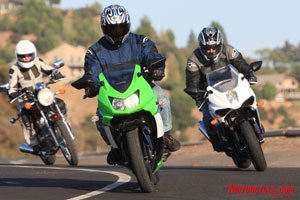 The Ninja 250R has been leader of the 250 pack for years, but as of 2009/10 some serious contenders are hot on the Ninja’s tail.
The Ninja 250R has been leader of the 250 pack for years, but as of 2009/10 some serious contenders are hot on the Ninja’s tail.
But with a 13,000 rpm redline and fleet-footed handling, the Ninja found a home in club-level racing over the past two decades, as well as with cagey veteran riders looking to embarrass bigger bikes in the canyons.
Of the 2008 overhaul, Kawasaki says 70% of the 250R’s Parallel-Twin has been re-designed, including new cams and a revised cylinder head, to result in a claimed 30% bump in mid-range power. Regardless of claims, dyno results showed the Ninja churned out the most power in the group, with 24.6 hp at 10,500 rpm and 12.6 ft-lbs at 9,750 rpm.
Impressive figures in this crowd, but who wants to scream around at 10K rpm all the time? The reality is that most folks gleefully whipping around on the Ninja will be doing so on surface streets. The engine will spend the majority of its time in lower rpms in this environment, and it’s at these lower revs where the Kawi suffers.
During the Ninja 250R’s 2008 overhaul, Kawasaki’s perception of the U.S. market was that consumers wouldn’t be as interested if the bike breached the $4,000 threshold. An unfortunate consequence of staying south of that retail figure meant the Ninja would continue to inhale through a pair of Keihin carbs, carbs that are seriously leaned out by ever-stricter exhaust emissions standards.
|
|
“It’s very cold-blooded,” said Duke of the Kawi. “Even in mid-60s temps it requires full choke and will not accept any throttle until after it runs for a few minutes.” He further noted the carbs run lean even when the bike is fully warmed. “This would be a deal-breaker if it couldn’t be tuned out. If I bought one, I’d buy a jet kit the same day.”
A short first gear is used to help mitigate gutless bottom-end power, but so short is first that a rider is immediately upshifting once under way. However, in this group, the Ninja’s Twin is one of the smoothest mills when up to freeway speeds.
 The Ninja 250R is and probably will be for some time to come, a great handling bike, regardless of its budget-conscious market position.
The Ninja 250R is and probably will be for some time to come, a great handling bike, regardless of its budget-conscious market position.
Light steering action, a stable chassis and good brake performance from the single dual-piston sliding-pin caliper/rotor combo up front help offset annoyances from the engine’s wheezy low-end performance.
“…the Ninja’s Twin is one of the smoothest mills when up to freeway speeds.”
A large part of the Ninja’s attraction is an ergo package that welcomes shorter inseam folks. Yet, even the average height Joe can find the 250R a tad cramped at points, like the tight seat to peg relation.
Thirty-three-inch inseam Tom discovered his knees didn’t fit neatly into the fuel tank cutouts, but he found this issue to be more “distraction than discomfort.”
On the upside, Tom admired the neutral riding position and good steering leverage the nearly 2-inch-rise bars afford the rider. In contrast, Short Person Representative, Alice, said she found the riding position “a tad sporty for everyday running around town.”
The Kawasaki Ninja 250R is the class icon, and for good reason. An overall friendly rider environment, a tame but rev-ready engine, and big sportbike looks attract riders by the droves. Too bad these current economic times have driven the 2010 Ninja 250R’s MSRP well past that $4,000 mark, and yet it still doesn’t benefit from fuel-injection like two of the five bikes in this test do.
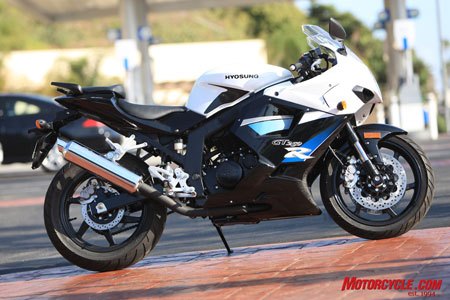 |
Hyosung GT250R $3,999–4,199 depending on color choice
32.7-inch seat height, claimed wet weight 414 lbs, 2 yr warranty
We don’t ride motorcycles from Korea-based Hyosung that often, but perhaps we’ll soon change that status.
The GT250R offers great value. To the untrained eye it looks like a larger displacement and more expensive sportbike.
Its 249cc, air/oil-cooled, DOHC, 5-speed, 75-degree V-Twin makes a Ninja-competitive 22.6 horsepower at 10,250 rpm and 13.8 ft-lbs at 6,750 rpm. But just as important as final output is the Hyosung’s use of fuel-injection! And it comes in right around that $4,000 mark.
|
|
A pair of two-piston sliding-pin calipers squeezing a set of 300mm rotors is another area where the GT outpaces the Ninja. Although feel from the GT’s front brake was initially disappointingly weak, by the end of the test Duke sensed greater feel and improved power, likely due to the pads bedding-in on this fresh example.
Along with engine performance, the Hyosung’s chassis also has the Ninja looking over its shoulder.
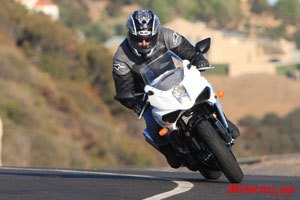 The Hyosung GT250R is aimed squarely at snatching away the huge share of the lightweight market share that the Ninja 250R holds. With bigger bike looks, respectable power from its V-Twin, good handling and fuel-injection, the GT250R is in the hunt!
The Hyosung GT250R is aimed squarely at snatching away the huge share of the lightweight market share that the Ninja 250R holds. With bigger bike looks, respectable power from its V-Twin, good handling and fuel-injection, the GT250R is in the hunt!
The Kawasaki’s lighter-feeling steering response is partially attributable to its nearly 40 lbs lighter weight compared to the GT250R. The Ninja also boasts a 1.4-inch shorter wheelbase (55.1” vs 56.5”), while steering geometry is kind of a wash between the Kawi and Hyosung (26 degree rake/3.2” trail vs. 25 degree rake/3.7” trail).
Despite carrying more weight, and dimensions not as edgy as the Kawasaki, the Hyosung is nonetheless spry and yet stable. If the pair was pitted in battle on the track, it’s anyone’s guess the final outcome. We think the GT is that close to the Ninja.
And in some ways maybe the GT is a step ahead, as it’s more manageable on the street with smoother fueling thanks to EFI. And, most importantly, it has a considerable midrange power advantage over the revvier Ninja.
Where the GT will probably be divisive with prospective buyers is with its ergos.
This bike has the most aggressive riding position, with clip-on placement below the top triple clamp putting the rider in committed position, much like a modern supersport. And the highest seat height here will turn off many people in the market for a 250.
Alice, who stands 5-feet, one-inch, with a 28-inch inseam, wasn’t able to comfortably saddle up. Yet the youthful sport rider on a budget might be drawn to the GT for these vary reasons. It looks and feels like a big sportbike.
|
|
Styling is also a strong quality on the GT. As Alice noted, “anodized bits make it look like a real sportbike.” An inverted fork (though it’s unadjustable) also creates a pricier appearance.
Ol’ man Duke quickly pointed out the GT’s instrument cluster is robust and up-to-date with a digital speedo, analog tach, dual tripmeters, and even offers adjustable backlighting. There’s decent wind protection, the footpegs are adjustable as is the brake lever, and the taillight is LED. In terms of power and handling, it handles two-up riding better than expected for a 250.
A surprise fly in the ointment was its turnsignals that quit working halfway through the test. This isn’t something you’ll typically find on a Japanese motorcycle, so we were left with some skepticism about quality control at Hyosung.
However, we’re not nearly as skeptical of the Hyosung as of, say, another bike or two in this shootout…
 |
Suzuki TU250X $3,799
30.3-inch seat height, claimed curb weight 328 lbs, 12 month warranty
You could make a case for why any of the contestants in this review are the right machine for you. But considering that user-friendliness is a key element of what many buyers in the small-displacement/beginner market segment are looking, it’s hard not to put Suzuki’s TU250X at the top of the heap.
We recently reviewed Suzuki’s TU250X, and praised it for its ability to bring elemental motorcycling and classic UJM looks together with fuel-injection.
Its little 249cc, air-cooled, SOHC Thumper only managed a fourth place finish in output (15.4 hp at 7,250 rpm and 11.6 at 6,750 rpm), but excellent throttle response and a smooth linear pull at low rpm make the TU feel potent. The 5-speed gearbox and clutch action are excellent, and suspension is remarkably well balanced for a budget bike.
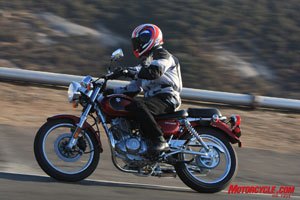 Fuel-injection, a strong but smooth 250 Thumper, easy, upright ergos and tasteful styling. What’s not to like about the TU?
Fuel-injection, a strong but smooth 250 Thumper, easy, upright ergos and tasteful styling. What’s not to like about the TU?
Alice got some pillion time on the TU and remarked that passenger pegs and the grab handle are placed in just the right positions for a very cozy ride on the back. When she piloted the little Zook, she loved the fact that even she could plant both boots flat, and that the controls were comfortably within reach. The TU boosts rider confidence thanks to its solid, stable feel in the corners.
When it came time for Alice to contemplate any drawbacks from the TU, her response was, “None!”
Although the five test riders on this trip are highly experienced riders – three have or had racing creds – we all enjoyed the TU250X the most of any bike here for all the same reasons that a beginner would enjoy it.
The TU’s upright ergos, low seat height, easily modulated but powerful solitary front brake caliper, spot-on fuel-injection, sufficient engine performance and an overall light feel create an ultra-manageable nature.
Whether it’ll be your first or your 50th bike, Suzuki’s TU250X is one fun ride! And riding fun is what it’s all about.
|
|
Related Reading
2008 Kawasaki Ninja 250R Review
2009 Suzuki TU250X Review
2009 QLINK XF200 Review
2009 Honda CRF230M Review
2009 Johnny Pag Motorcycles Review
All Motorcycle Reviews on Motorcycle.com
The post Church of MO: 2009 250cc Streetbike Shootout appeared first on Motorcycle.com.
【Top 10 Malaysia & Singapore Most Beautiful Girls】Have you follow?
 Five options for the 250cc buyer. Some are outstanding examples of what’s available today, and some are, well, just examples.
Five options for the 250cc buyer. Some are outstanding examples of what’s available today, and some are, well, just examples.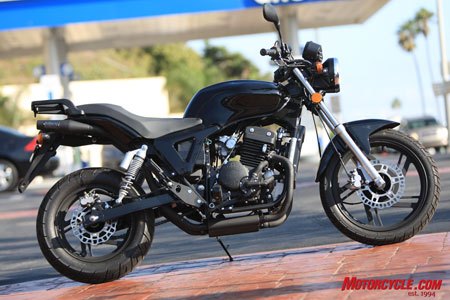 The Johnny Pag FX/3: nolo contendere.
The Johnny Pag FX/3: nolo contendere. The Gene’s Speed Shop dyno proved the FX/3 (orange trace) has competitive power, but our favorite engine overall was the air-cooled and fuel-injected V-Twin in the Hyosung GT250R (blue). The Suzuki’s injected Thumper (red) feels stronger than its modest peak numbers suggest.
The Gene’s Speed Shop dyno proved the FX/3 (orange trace) has competitive power, but our favorite engine overall was the air-cooled and fuel-injected V-Twin in the Hyosung GT250R (blue). The Suzuki’s injected Thumper (red) feels stronger than its modest peak numbers suggest.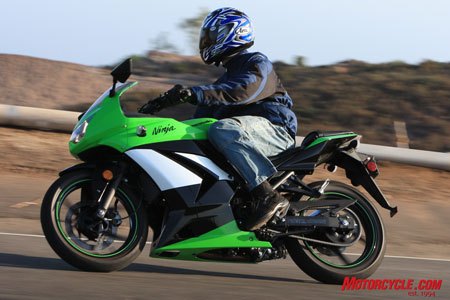 A great color scheme and big-boy styling make the littlest Ninja look like a supersport-level sportbike. Note the color-matched trim on the wheels of our “Special Edition” version.
A great color scheme and big-boy styling make the littlest Ninja look like a supersport-level sportbike. Note the color-matched trim on the wheels of our “Special Edition” version.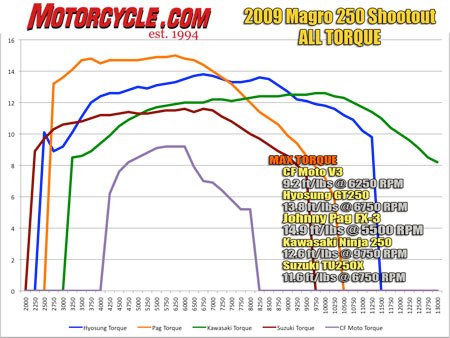 The CFMoto’s (purple trace) CVT transmission complicated dyno testing because it obviously can’t be held in a constant gear ratio. Note the Suzuki’s (orange) instant torque down low. Also note how the Hyosung’s blue line has a clear advantage over the Ninja’s green line in all areas below 9000 rpm.
The CFMoto’s (purple trace) CVT transmission complicated dyno testing because it obviously can’t be held in a constant gear ratio. Note the Suzuki’s (orange) instant torque down low. Also note how the Hyosung’s blue line has a clear advantage over the Ninja’s green line in all areas below 9000 rpm. Good luck finding a small sportbike that looks as attractive as the GT250R, and provides EFI, all for around $4K.
Good luck finding a small sportbike that looks as attractive as the GT250R, and provides EFI, all for around $4K.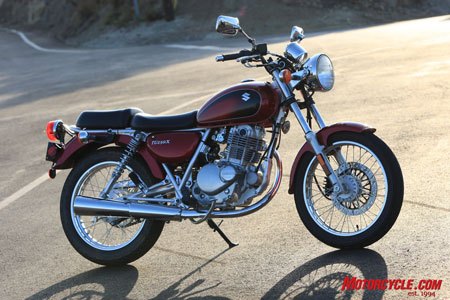 The Suzuki TU250X: a modern classic.
The Suzuki TU250X: a modern classic.